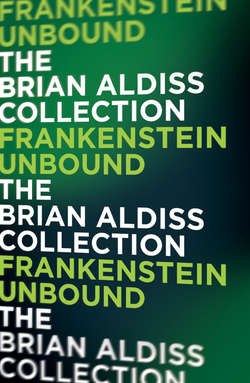Читать книгу Frankenstein Unbound - Brian Aldiss - Страница 6
Introduction
ОглавлениеI had no hesitation. I was obsessed with the matter of Mary Shelley’s Frankenstein: its tenderness and brutal remorse, and, beyond all that, its consideration of the difficulties of life that face us. So I got up one morning and eagerly began writing this novel.
In a sense, I was just doing a duty, for I felt that anyone interested in the macabre or the mystical should not fail to read Mary Shelley’s novel. I was determined that my answering novel should embody simple human joys and sorrows: the loss of a mother, the loss of direction, the loss of a feeling for common humanity. But for all that, it should just be a grand little story …
Mary Shelley wrote Frankenstein whilst still in her teens – a remarkable feat. We feel in her writing resonances of Caleb Williams, arguably the finest novel written by her father, the political philosopher William Godwin.
When I wrote my history of science fiction (Billion Year Spree), I claimed Frankenstein to be the first British work to which the label science fiction can be logically attached – particularly impressive in a field long dominated by men.
My sensibilities were already telling me that for science fiction to really find acknowledgement as literature it should not simply embrace science, but should attempt to involve that wider world in which we live and move and have our being.
So I embarked on this present book. It was first published by Jonathan Cape in 1973.
My main character, Joe Bodenland, is taken back in time from our present to a period early in the nineteenth century, where Mary Shelley is beginning to write her book in Switzerland. There Bodenland stands, in a realm where Percy Bysshe Shelley and Lord Byron are nearby.
Though Bodenland ultimately has to meet the monster, he fares best when he meets Mary herself. She tells him she is ‘setting up shop as a connoisseur of grave stories’. Her knowledge of science, or some science, is first demonstrated when they discuss the variety of weather conditions. In fact, the weather in 1816 was bizarre – an immense volcanic eruption off an Indonesian island caused ‘the year without summer’ in Europe.
Bodenland encounters the monster near a great unaccountable city (a materialisation of the distant volcanic eruption, perhaps). Such events inevitably echo alarming proceedings in my own life. The novel ends with the same phrase concluding Mary Shelley’s novel.
Mary went on to make a career of writing. Among other things, she wrote six other novels. None of them have the strength of her first, which, we may conjecture, is imbued with the misery of her mother dying just a few days after Mary’s birth.
In Frankenstein Unbound, Bodenland and Mary take a swim together, and then make love. (This is what authors do when they are half in love with a female character. They call it sublimation. Bodenland, c’est moi!) The text declares that the Mary and Bodenland were ‘scarcely less than phantoms to each other’. There’s an admission! But the solid world beyond the lovers was no phantom, and it is there that the rest of my story lies.
Brian Aldiss
Oxford, 2013
